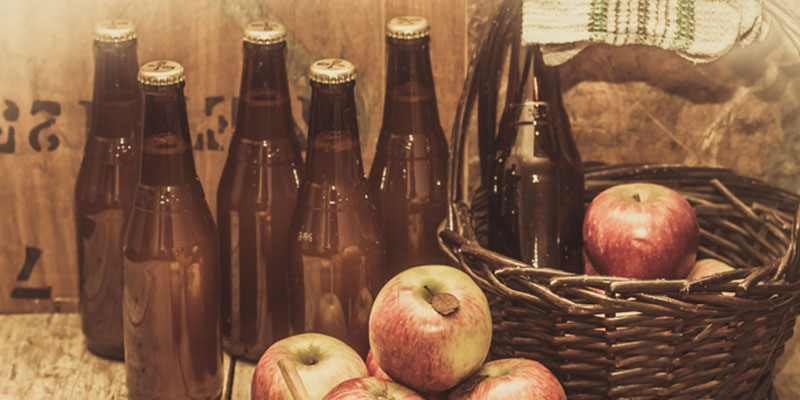Ryan Burk only wants one thing. The head cider maker at Angry Orchard wants to put numbers on his cider labels. Not just any numbers, either. Burk wants to advertise the year of the apple harvest that resulted in the cider in your bottle. This practice of putting a year on a bottle actually has a name — it’s one you know well from wine: It’s called a vintage, and it signals to consumers all kinds of information about the fruit that’s in their beverages. You wouldn’t expect a Sauvignon Blanc from 2013 to taste the same as a Sauvignon Blanc from 2016, because the year the grapes were grown — the vintage — matters to the taste of the wine. Many influential cider makers believe that the same is true for cider: Each season results in a batch of apples that are different from those of any other year, and consumers should be informed about these differences. The problem is, Burk is not allowed to put the year or even the word “vintage” on his bottles.
The origin of cider’s troubles stems from the U.S.’s restrictive cider labeling laws, set by the Alcohol and Tobacco Tax and Trade Bureau, or the TTB. The restriction against advertising vintage on cider bottles goes back to the end of Prohibition. The Federal Alcohol Administration, or the FAA, was created in 1935 to regulate the newly legal alcohol products being produced and sold in the country. To do so, the Administration separated alcohol into three categories: wine, beer, and spirits (if those broad designations seem a little lacking, remember that the people making these laws hadn’t been able to have a legal drink for 13 years).
Those three categories left cider to linger awkwardly betwixt and between — not quite beer, but not quite wine, either. Cider was designated as “fruit wine.” To this day, cider continues to stymie regulators, like those in Massachusetts who recently faced a conundrum over whether to tax cider as Champagne or beer.
On the TTB and FAA websites, cider is still labeled as a fruit wine, meaning it must be “produced by the normal alcoholic fermentation of the juice of sound, ripe apples.” But when it comes to the TTB’s labeling laws, only grape wine can use the “vintage” labels.
It’s a law that Burk desperately wants changed, and he is far from alone. The law forbidding cider makers from using a vintage date gives consumers the false impression that cider is more beer-like than wine-like. “That’s just not true,” Michelle McGrath, executive director at the United States Association of Cider Makers, tells VinePair over the phone. “Cider is more like wine than it is like beer,” she argues. And it’s not just semantics. The misperception hurts cider as a whole, McGrath says, because people are “missing the fundamental understanding of when the apples were grown, where they were made, etc.” The USACM is a 1,300-member organization that lobbies on behalf of the national cider market, and the next big push on its list is getting cider on a more level playing field with wine through vintage designation.
It’s a uniquely American problem. In other cider-producing countries, producers are free to choose whether to list a vintage on their labels. Spain, one of the premier cider-producing countries, allows producers to put the vintage year on the label.
But it’s actually not typical for foreign cider makers to use vintages, even though it’s perfectly legal. So says James Asbel, owner of Ciders of Spain. Spanish cider makers typically blend juice from different orchards, even different years. This is because, Asbel tells VinePair over the phone, apples just aren’t as complex as grapes.
That said, Asbel believes that people should be able to put whatever they want on their labels to help convey what’s inside the bottle. He’s “not for regulation and certification of any kind, except for health and human well-being,” he says. But he emphasized that this may be more of a branding question than a qualitative one. “I endorse the notion, but at the same time it has to be observed that it is a program to give people a unique advantage,” Asbel, who is also an associate member of the USACM, says.
The TTB didn’t respond to multiple requests for comment. But even McGrath doesn’t think it’s maliciousness that is driving this inertia to change the law. “I don’t think it’s anything personal against the cider,” she told VinePair. “I think it’s just wine protecting what makes them special, and cider just got caught in the crosshairs.”
Cider makers have struggled to get around the restrictions by using identifiers like batch numbers instead of years, and changing the label every year to signal the difference from the previous year. In the meantime, the USACM is looking ahead to addressing the TTB to lobby for a change to the regulations in the near future. But there’s no set timeline.
In the meantime, specialty cider makers in the community remain frustrated. “Whatever the rules around wine are, I would take them,” Eleanor Leger, the owner of Eden Ice Ciders, tells VinePair over the phone. “Just let me do it with apples.”

